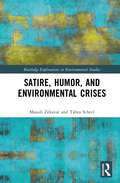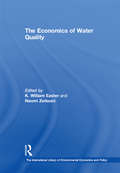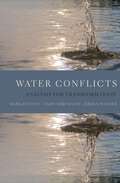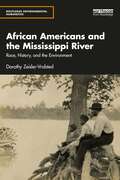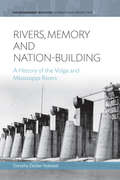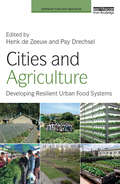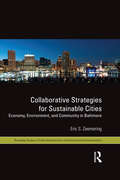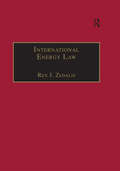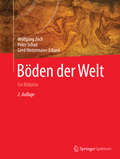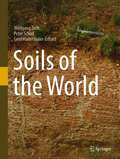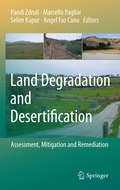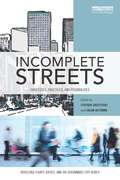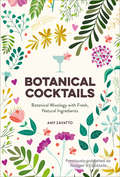- Table View
- List View
The Adventures of a Curious Cat: wit and wisdom from Curious Zelda, purrfect for cats and their humans
by Curious Zelda'Curiosity is more than a desire to discover. It's a lifestyle, and a purrvilege. It's hours of observing a fly on the wall. It's entering the sock drawer just before it closes. It's sniffing the lampshade one more time . . .'Such is the wisdom of Curious Zelda: social media star, agony aunt, yoga teacher, cat. In The Adventures of a Curious Cat she gives insight into her view of the world and dispenses unparalleled wisdom. Zelda explains, in her unique voice, how to handle humans, how to communicate with furniture, and most importantly how to live a life curiously. It's the ultimate self-help guide for any cat, or indeed, their human.
Satire, Humor, and Environmental Crises (Routledge Explorations in Environmental Studies)
by Massih Zekavat Tabea ScheelSatire, Humor, and Environmental Crises explores how satire and humor can be employed to address and mitigate ecological crises at individual and collective levels. Besides scientific and technological endeavors, solutions to ecological crises must entail social and communicative reform to persuade citizens, corporations, organizations, and policymakers to adopt more sustainable lifestyles and policies. This monograph reassesses environmental behavior and messaging and explores the promises of humorous and satiric communication therein. It draws upon a solid and interdisciplinary theoretical foundation to explicate the individual, social, and ecospheric determinants of behavior. Creative works of popular culture across various modes of expression, including The Simpsons, Last Week Tonight with John Oliver, and The New Yorker cartoons, are examined to illustrate the strong if underappreciated relationship between humor and the environment. This is followed by a discussion of the instruments and methodological subtleties involved in measuring the impacts of humor and satire in environmental advocacy for the purpose of conducting empirical research. More broadly, the book aspires to participate in urgent cultural and political discussions about how we can evaluate and intervene in the full diversity of environmental crises, engage a broad set of internal and external partners and stakeholders, and develop models for positive social and environmental transformations. This book will be of great interest to students and scholars interested in environmental humanities, communication science, psychology, and critical humor studies. It can further benefit environmental activists, policymakers, NGOs, and campaign organizers.
Satire, Humor, and Environmental Crises (Routledge Explorations in Environmental Studies)
by Massih Zekavat Tabea ScheelSatire, Humor, and Environmental Crises explores how satire and humor can be employed to address and mitigate ecological crises at individual and collective levels. Besides scientific and technological endeavors, solutions to ecological crises must entail social and communicative reform to persuade citizens, corporations, organizations, and policymakers to adopt more sustainable lifestyles and policies. This monograph reassesses environmental behavior and messaging and explores the promises of humorous and satiric communication therein. It draws upon a solid and interdisciplinary theoretical foundation to explicate the individual, social, and ecospheric determinants of behavior. Creative works of popular culture across various modes of expression, including The Simpsons, Last Week Tonight with John Oliver, and The New Yorker cartoons, are examined to illustrate the strong if underappreciated relationship between humor and the environment. This is followed by a discussion of the instruments and methodological subtleties involved in measuring the impacts of humor and satire in environmental advocacy for the purpose of conducting empirical research. More broadly, the book aspires to participate in urgent cultural and political discussions about how we can evaluate and intervene in the full diversity of environmental crises, engage a broad set of internal and external partners and stakeholders, and develop models for positive social and environmental transformations. This book will be of great interest to students and scholars interested in environmental humanities, communication science, psychology, and critical humor studies. It can further benefit environmental activists, policymakers, NGOs, and campaign organizers.
The Economics of Water Quality (The International Library of Environmental Economics and Policy)
by Naomi ZeitouniThis volume brings together a number of prominent economic studies all of which deal with key water quality issues. The studies focus on the economic aspects of water quality including identifying the polluters' actions and incentives, designing and comparing control mechanisms, analyzing the costs and benefits of water quality programmes, and finally managing transboundary water quality. They all make recommendations for improving water quality through changing incentives, programmes and/or policies.
The Economics of Water Quality (The International Library of Environmental Economics and Policy)
by Naomi ZeitouniThis volume brings together a number of prominent economic studies all of which deal with key water quality issues. The studies focus on the economic aspects of water quality including identifying the polluters' actions and incentives, designing and comparing control mechanisms, analyzing the costs and benefits of water quality programmes, and finally managing transboundary water quality. They all make recommendations for improving water quality through changing incentives, programmes and/or policies.
Water Conflicts: Analysis for Transformation
by Mark Zeitoun Jeroen Warner Naho MirumachiWater Conflicts applies cutting-edge thinking to identify pathways that can transform complex water conflicts. It challenges existing power-blind and politics-lite analysis that is very deeply-held and recurring in debates that suggest causal links between scarcity and violence-or peace. This book presents a much needed revision of transboundary water analysis, leading to a rethink on the way water is used and contested, with a focus on harm experienced both by the most vulnerable water users and the environment. Recognizing that conflicts are never static, Mark Zeitoun, Naho Mirumachi, and Jeroen Warner's "transformative analysis" provides multi-disciplinary tools and perspectives to understand and address the complexities involved. The approach is stress-tested through dozens of examples around the globe, and it incorporates collective evidence and knowledge of the London Water Research Group. The insights on water diplomacy will be most welcome by analysts, activists, diplomats, and all others tackling water conflicts. Seeking to motivate improvement of transboundary water arrangements towards further equity and sustainability as a practical agenda, the book is a fresh antidote to the detached role that researchers and policymakers often play.
Water Conflicts: Analysis for Transformation
by Mark Zeitoun Naho Mirumachi Jeroen WarnerWater Conflicts applies cutting-edge thinking to identify pathways that can transform complex water conflicts. It challenges existing power-blind and politics-lite analysis that is very deeply-held and recurring in debates that suggest causal links between scarcity and violence-or peace. This book presents a much needed revision of transboundary water analysis, leading to a rethink on the way water is used and contested, with a focus on harm experienced both by the most vulnerable water users and the environment. Recognizing that conflicts are never static, Mark Zeitoun, Naho Mirumachi, and Jeroen Warner's "transformative analysis" provides multi-disciplinary tools and perspectives to understand and address the complexities involved. The approach is stress-tested through dozens of examples around the globe, and it incorporates collective evidence and knowledge of the London Water Research Group. The insights on water diplomacy will be most welcome by analysts, activists, diplomats, and all others tackling water conflicts. Seeking to motivate improvement of transboundary water arrangements towards further equity and sustainability as a practical agenda, the book is a fresh antidote to the detached role that researchers and policymakers often play.
Reflections: Understanding Our Use and Abuse of Water
by Mark ZeitounWater is central to all life, but we use it to destroy. Water can nourish, but we use it to starve. It can cleanse and unify, but we ensure it contaminates and divides. The consequences of continuing to desecrate or beginning to restore water's inner grace are tremendousand will reflect as much on us as portend our future. Drawing upon twenty-five years of professional work as a water engineer, negotiator, and scholar, Mark Zeitoun provides a unique insider's account of this phenomenon. He explains how unchecked assumptions about water mix with political and economic systems to create an insatiable and ruinous thirst for ever more water. He shows how we use water to lethal effect in wars, and demolish drinking-water systems with wanton disregard. He questions why we transform the most majestic of rivers into canals which spark international conflict and challenge our capacity for preventative diplomacy. The answers reflect more about our society than we might care to admit. If we are to restore water's inner grace, Zeitoun argues, we should worry not so much about "saving" water, but think about what we do with it when it is in our hands.
Reflections: Understanding Our Use and Abuse of Water
by Mark ZeitounWater is central to all life, but we use it to destroy. Water can nourish, but we use it to starve. It can cleanse and unify, but we ensure it contaminates and divides. The consequences of continuing to desecrate or beginning to restore water's inner grace are tremendousand will reflect as much on us as portend our future. Drawing upon twenty-five years of professional work as a water engineer, negotiator, and scholar, Mark Zeitoun provides a unique insider's account of this phenomenon. He explains how unchecked assumptions about water mix with political and economic systems to create an insatiable and ruinous thirst for ever more water. He shows how we use water to lethal effect in wars, and demolish drinking-water systems with wanton disregard. He questions why we transform the most majestic of rivers into canals which spark international conflict and challenge our capacity for preventative diplomacy. The answers reflect more about our society than we might care to admit. If we are to restore water's inner grace, Zeitoun argues, we should worry not so much about "saving" water, but think about what we do with it when it is in our hands.
African Americans and the Mississippi River: Race, History, and the Environment (Routledge Environmental Humanities)
by Dorothy Zeisler-VralstedThis book follows the historical trajectory of African Americans and their relationship with the Mississippi River dating back to the 1700s and ending with Hurricane Katrina and the still-contested Delta landscape. Long touted in literary and historical works, the Mississippi River remains an iconic presence in the American landscape. Whether referred to as "Old Man River" or the "Big Muddy," the Mississippi River represents imageries ranging from the pastoral and Acadian to turbulent and unpredictable. However, these imageries—revealed through the cultural production of artists, writers, poets, musicians, and even filmmakers—did not reflect the experiences of everyone living and working along the river. Missing is a broader discourse of the African American community and the Mississippi River. Through the experiences of African Americans with the Mississippi River, which included narratives of labor (free and enslaved), refuge, floods, and migration, a different history of the river and its environs emerges. The book brings multiple perspectives together to explore this rich history of the Mississippi River through the intersection of race and class with the environment. The text will be of great interest to students and researchers in environmental humanities, including environmental justice studies, ethnic studies, and US and African American history.
African Americans and the Mississippi River: Race, History, and the Environment (Routledge Environmental Humanities)
by Dorothy Zeisler-VralstedThis book follows the historical trajectory of African Americans and their relationship with the Mississippi River dating back to the 1700s and ending with Hurricane Katrina and the still-contested Delta landscape. Long touted in literary and historical works, the Mississippi River remains an iconic presence in the American landscape. Whether referred to as "Old Man River" or the "Big Muddy," the Mississippi River represents imageries ranging from the pastoral and Acadian to turbulent and unpredictable. However, these imageries—revealed through the cultural production of artists, writers, poets, musicians, and even filmmakers—did not reflect the experiences of everyone living and working along the river. Missing is a broader discourse of the African American community and the Mississippi River. Through the experiences of African Americans with the Mississippi River, which included narratives of labor (free and enslaved), refuge, floods, and migration, a different history of the river and its environs emerges. The book brings multiple perspectives together to explore this rich history of the Mississippi River through the intersection of race and class with the environment. The text will be of great interest to students and researchers in environmental humanities, including environmental justice studies, ethnic studies, and US and African American history.
Rivers, Memory, And Nation-building: A History of the Volga and Mississippi Rivers (Environment in History: International Perspectives #5)
by Dorothy Zeisler-VralstedRivers figure prominently in a nation’s historical memory, and the Volga and Mississippi have special importance in Russian and American cultures. Beginning in the pre-modern world, both rivers served as critical trade routes connecting cultures in an extensive exchange network, while also sustaining populations through their surrounding wetlands and bottomlands. In modern times, “Mother Volga” and the “Father of Waters” became integral parts of national identity, contributing to a sense of Russian and American exceptionalism. Furthermore, both rivers were drafted into service as the means to modernize the nation-state through hydropower and navigation. Despite being forced into submission for modern-day hydrological regimes, the Volga and Mississippi Rivers persist in the collective memory and continue to offer solace, recreation, and sustenance. Through their histories we derive a more nuanced view of human interaction with the environment, which adds another lens to our understanding of the past.
Cities and Agriculture: Developing Resilient Urban Food Systems (Earthscan Food and Agriculture)
by Henk De Zeeuw Pay DrechselAs people increasingly migrate to urban settings and more than half of the world's population now lives in cities, it is vital to plan and provide for sustainable and resilient food systems which reflect this challenge. This volume presents experience and evidence-based "state of the art" chapters on the key dimensions of urban food challenges and types of intra- and peri-urban agriculture. The book provides urban planners, local policy makers and urban development practitioners with an overview of crucial aspects of urban food systems based on an up to date review of research results and practical experiences in both developed and developing countries. By doing so, the international team of authors provides a balanced textbook for students of the growing number of courses on sustainable agriculture, food and urban studies, as well as a solid basis for well-informed policy making, planning and implementation regarding the development of sustainable, resilient and just urban food systems.
Cities and Agriculture: Developing Resilient Urban Food Systems (Earthscan Food and Agriculture)
by Henk De Zeeuw Pay DrechselAs people increasingly migrate to urban settings and more than half of the world's population now lives in cities, it is vital to plan and provide for sustainable and resilient food systems which reflect this challenge. This volume presents experience and evidence-based "state of the art" chapters on the key dimensions of urban food challenges and types of intra- and peri-urban agriculture. The book provides urban planners, local policy makers and urban development practitioners with an overview of crucial aspects of urban food systems based on an up to date review of research results and practical experiences in both developed and developing countries. By doing so, the international team of authors provides a balanced textbook for students of the growing number of courses on sustainable agriculture, food and urban studies, as well as a solid basis for well-informed policy making, planning and implementation regarding the development of sustainable, resilient and just urban food systems.
Collaborative Strategies for Sustainable Cities: Economy, Environment and Community in Baltimore (Routledge Studies in Public Administration and Environmental Sustainability)
by Eric S. ZeemeringBaltimore, like many other cities around the globe, is redesigning local government policy and programs in order to become a more sustainable city. Sustainability, as a concept guiding public action, encourages city officials to integrate policy and programs addressing the economic, environmental, and social health of the community. City governments, including Baltimore, have adopted plans to integrate this new priority into local policy and program management. Reorienting city policy and programs to address an emergent concern like sustainability requires collaboration between city government and various actors and organizations in the community. Collaborative Strategies for Sustainable Cities examines how cities define sustainability and form policy implementation networks to integrate sustainability into city programs. Using the city of Baltimore to describe and analyze the involvement of the participants in local sustainability efforts in rich detail, Eric S. Zeemering argues that when we think about the sustainable city, the city government is not the best unit of analysis for our investigations or policy planning. Instead, policy networks within cities carve out slices of a sustainability agenda, define sustainability in their own ways, and form implementation networks with city government officials, neighborhood and community organizations, funders, and state and federal agencies in order to achieve specific goals. When cities begin to integrate sustainability into policies and programs, surveying and understanding competing definitions of sustainability within the community may be central to their success. The book’s rich array of data, including qualitative data from elite interviews and public documents, Q-methodology and social network analysis will make for an engaging read to scholars of political science or public affairs as well as the interested citizen or policy advocate.
Collaborative Strategies for Sustainable Cities: Economy, Environment and Community in Baltimore (Routledge Studies in Public Administration and Environmental Sustainability)
by Eric S. ZeemeringBaltimore, like many other cities around the globe, is redesigning local government policy and programs in order to become a more sustainable city. Sustainability, as a concept guiding public action, encourages city officials to integrate policy and programs addressing the economic, environmental, and social health of the community. City governments, including Baltimore, have adopted plans to integrate this new priority into local policy and program management. Reorienting city policy and programs to address an emergent concern like sustainability requires collaboration between city government and various actors and organizations in the community. Collaborative Strategies for Sustainable Cities examines how cities define sustainability and form policy implementation networks to integrate sustainability into city programs. Using the city of Baltimore to describe and analyze the involvement of the participants in local sustainability efforts in rich detail, Eric S. Zeemering argues that when we think about the sustainable city, the city government is not the best unit of analysis for our investigations or policy planning. Instead, policy networks within cities carve out slices of a sustainability agenda, define sustainability in their own ways, and form implementation networks with city government officials, neighborhood and community organizations, funders, and state and federal agencies in order to achieve specific goals. When cities begin to integrate sustainability into policies and programs, surveying and understanding competing definitions of sustainability within the community may be central to their success. The book’s rich array of data, including qualitative data from elite interviews and public documents, Q-methodology and social network analysis will make for an engaging read to scholars of political science or public affairs as well as the interested citizen or policy advocate.
International Energy Law: Rules Governing Future Exploration, Exploitation and Use of Renewable Resources
by Rex J. ZedalisThe international legal rules affecting renewable alternative energy resources are amongst the most important legal and environmental concerns of the near future. As traditional energy sources are depleted, new technologies are being developed to harness the potentials of wave, current and tidal energy, coastal wind power, offshore geothermal, polar energy resources and space-based solar collection. This book is the first comprehensive analysis of the legal rules governing the alternative energy resource potential of all international common areas - the high seas, the polar zones (especially Antarctica) and outer space. In a detailed, but precisely analyzed text, the book also reviews the international environmental rules affecting exploration, exploitation and use of internationally situated energy resources, alongside resources located offshore under national jurisdictions. This is accompanied by a critical look at the connection between efforts to control greenhouse gases and the growing interest in non-polluting alternatives found in the international "commons . The result is a work of unprecedented value for environmental and international law academics and practitioners, as well as those interested in environmental resource economics and politics.
International Energy Law: Rules Governing Future Exploration, Exploitation and Use of Renewable Resources
by Rex J. ZedalisThe international legal rules affecting renewable alternative energy resources are amongst the most important legal and environmental concerns of the near future. As traditional energy sources are depleted, new technologies are being developed to harness the potentials of wave, current and tidal energy, coastal wind power, offshore geothermal, polar energy resources and space-based solar collection. This book is the first comprehensive analysis of the legal rules governing the alternative energy resource potential of all international common areas - the high seas, the polar zones (especially Antarctica) and outer space. In a detailed, but precisely analyzed text, the book also reviews the international environmental rules affecting exploration, exploitation and use of internationally situated energy resources, alongside resources located offshore under national jurisdictions. This is accompanied by a critical look at the connection between efforts to control greenhouse gases and the growing interest in non-polluting alternatives found in the international "commons . The result is a work of unprecedented value for environmental and international law academics and practitioners, as well as those interested in environmental resource economics and politics.
Böden der Welt: Ein Bildatlas
by Wolfgang Zech Peter Schad Gerd Hintermaier-ErhardBöden gehören zu den wichtigsten Lebensgrundlagen der Menschheit. Sie unterscheiden sich in den verschiedenen Regionen der Erde außerordentlich stark. Dieser Bildatlas beschreibt und illustriert die Böden der Welt im Zusammenhang mit ihren Naturräumen.Grundlage ist die internationale Bodenklassifikation WRB (World Reference Base for Soil Resources) in der Neuauflage von 2006. Darin sind zahlreiche Begriffe neu bzw. schärfer definiert. Mit den Technosolen und Stagnosolen fanden zwei neue Referenzbodengruppen Aufnahme. Auch die weitere Untergliederung der Böden mit Hilfe von Qualifiern wurde deutlich verändert und erweitert. Diese zahlreichen Änderungen in der WRB von 2006 sind in die 2. Auflage des Buches eingegangen.Das Buch ist nach Ökozonen gegliedert. Für jede Ökozone werden Lage, Klima und Vegetation mit den sich daraus ergebenden bodenbildenden Faktoren beschrieben. Darauf folgen umfassende Informationen über deren repräsentative Böden:Definition der Böden,diagnostische Horizonte, Eigenschaften und Materialien,physikalische, chemische und biologische Merkmale,Vorkommen und Verbreitung,Nutzung und Gefährdung,Prozesse der Bodenbildung.Zahlreiche Diagramme zur Verbreitung der Böden, zu Profilmerkmalen und bodenbildenden Prozessen sowie viele neue Farbfotos von Bodenprofilen und -landschaften machen den Bildatlas zu einem ausgezeichneten Referenzwerk. Studierende und Lehrende sowie Entscheidungsträger werden zudem mit grundlegenden Erkenntnissen der Bodenkunde, des Bodenschutzes und der Bodenfruchtbarkeit vertraut gemacht. Bevölkerungswachstum und Bodendegradation in tropischen Gebieten, deren Böden von Natur aus nur eingeschränkt fruchtbar sind, machen die Ernährungssicherung in besonderem Maße zu einer Aufgabe der Bodenkunde.
Soils of the World
by Wolfgang Zech Peter Schad Gerd Hintermaier-ErhardThis book describes and comprehensively illustrates the soils of the world in accordance with the worldwide WRB classification. The structure of the book follows the ecozone concept. For every ecozone, location, climate and vegetation as well as soil formation and distribution are presented. All soils representative of the corresponding ecozone are then described in detail: definition, properties, distribution, use, classification, genesis. Over 260 photographs illustrate soil profiles, soil details and landscapes. Instructive maps and graphs help understand soil properties and soil-forming processes and make the publication an excellent reference book about the world's soils.
Land Degradation and Desertification: Assessment, Mitigation And Remediation
by Pandi Zdruli Marcello Pagliai Selim Kapur Angel Faz CanoLand Degradation and Desertification: Assessment, Mitigation, and Remediation reports research results in sustainable land management and land degradation status and mitigation in 36 countries around the world. It includes background papers with continental and international perspectives dealing with land degradation and desertification studies. The book assembles various topics of interest for a large audience. They include carbon sequestration and stocks, modern techniques to trace the trends of land degradation, traditional and modern approaches of resource-base conservation, soil fertility management, reforestation, rangeland rehabilitation, land use planning, GIS techniques in desertification risk cartography, participatory ecosystem management, policy analyses and possible plans for action. Various climatic domains in Africa, Asia, Europe and The Americas are covered. The book will be of interest to a variety of environmental scientists, agronomists, national and international policy makers and a number of organizations dealing with sustainable management of natural resources.
Incomplete Streets: Processes, practices, and possibilities (Routledge Equity, Justice and the Sustainable City series)
by Stephen Zavestoski Julian AgyemanThe ‘Complete Streets' concept and movement in urban planning and policy has been hailed by many as a revolution that aims to challenge the auto-normative paradigm by reversing the broader effects of an urban form shaped by the logic of keeping automobiles moving. By enabling safe access for all users, Complete Streets promise to make cities more walkable and livable and at the same time more sustainable. This book problematizes the Complete Streets concept by suggesting that streets should not be thought of as merely physical spaces, but as symbolic and social spaces. When important social and symbolic narratives are missing from the discourse and practice of Complete Streets, what actually results are incomplete streets. The volume questions whether the ways in which complete streets narratives, policies, plans and efforts are envisioned and implemented might be systematically reproducing many of the urban spatial and social inequalities and injustices that have characterized cities for the last century or more. From critiques of a "mobility bias" rooted in the neoliberal foundations of the Complete Streets concept, to concerns about resulting environmental gentrification, the chapters in Incomplete Streets variously call for planning processes that give voice to the historically marginalized and, more broadly, that approach streets as dynamic, fluid and public social places. This interdisciplinary book is aimed at students, researchers and professionals in the fields of urban geography, environmental studies, urban planning and policy, transportation planning, and urban sociology.
Incomplete Streets: Processes, practices, and possibilities (Routledge Equity, Justice and the Sustainable City series)
by Stephen Zavestoski Julian AgyemanThe ‘Complete Streets' concept and movement in urban planning and policy has been hailed by many as a revolution that aims to challenge the auto-normative paradigm by reversing the broader effects of an urban form shaped by the logic of keeping automobiles moving. By enabling safe access for all users, Complete Streets promise to make cities more walkable and livable and at the same time more sustainable. This book problematizes the Complete Streets concept by suggesting that streets should not be thought of as merely physical spaces, but as symbolic and social spaces. When important social and symbolic narratives are missing from the discourse and practice of Complete Streets, what actually results are incomplete streets. The volume questions whether the ways in which complete streets narratives, policies, plans and efforts are envisioned and implemented might be systematically reproducing many of the urban spatial and social inequalities and injustices that have characterized cities for the last century or more. From critiques of a "mobility bias" rooted in the neoliberal foundations of the Complete Streets concept, to concerns about resulting environmental gentrification, the chapters in Incomplete Streets variously call for planning processes that give voice to the historically marginalized and, more broadly, that approach streets as dynamic, fluid and public social places. This interdisciplinary book is aimed at students, researchers and professionals in the fields of urban geography, environmental studies, urban planning and policy, transportation planning, and urban sociology.
Botanical Cocktails: Botanical Mixology With Fresh, Natural Ingredients
by Amy ZavattoCraft delicious wild cocktails from foraged and grown ingredients.
Forager’s Cocktails: Botanical Mixology With Fresh Ingredients
by Amy ZavattoCraft delicious wild cocktails from foraged and grown ingredients

